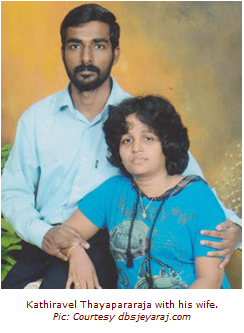
Sunday, 25th May 2014
By Shenali D. Waduge
The case of Kathiravel Thayapararaja appearing from the ‘dead’ cannot be taken lightly.
If not for his arrest by the Indian police the world would have continued to believe the University Teachers for Human Rights (UTHR-J) report, continued to accept the War without Witnesses report, the European Centre for Constitutional and Human Rights report and continued to rely on the Australian Government Refugee Review Tribunal report compiled under Country Advice against Sri Lanka.
These four entities declared that Sri Lankan Forces extra-judicially killed Kathiravel Thayapararaja on September 15, 2009 going so far as to even quote places of torture and place of hospitalisation.
This accusation of killing went on for five years with the name Kathiravel Thayapararaja quoted far and wide to showcase extra judicial killings by Sri Lankan security forces and form the basis for the ‘human rights mafia’ to descend on nations to ensure human rights prevail in these nations.
Before that agenda can take off, UTHR-J and others must make a public apology, in fact the legal department of the Sri Lankan Security forces must send a letter of demand seeking apology and compensation for tarnishing the image of Sri Lanka and its forces.
Falsehood
With the dead coming alive our next question is how many more dead are out there very much alive?
If not for the Dhanushkodi police in India, arresting the two boat loads of ‘refugees’ and Sri Lankan intelligence authorities quick to pick on the name and match the bonafides to the supposed dead, the world would have continued to believe in the lie cooked up by the University Teachers for Human Rights and the accusations reported by War without Witnesses and the countless other international humanitarian organisations quoting far and wide from these sources.
None of these reports will ever be changed and their publications will continue to carry that Kathiravel Thayapararaja was in fact abducted, tortured and killed by Sri Lankan Security forces months following the LTTE defeat in September 2009.
The falsehood concocted by the UTHR-J and quoted by international sources needs to be immediately addressed. There are too many examples of sweeping statements and reports taking place and being quoted internationally to ridicule and embarrass Sri Lanka's image and that of its forces.
Witnesses are eventually untraceable, uncontactable or they become ‘witnesses’ by virtue of here-say.
But the damage has been done and irreversible as is the intent with which the reports were launched.
A crafty ‘witness protection’ system being introduced enables a cap on the identity when in reality no such person exists because the accusations are all concocted and the case of Kathiravel Thayapararaja is just one good example.
Charade
Our next and most important question is Kathiravel Thayapararaja was an employee of a US NGO, surely the NGO with connections to the US would have known that Thayapararaja was alive and not dead.
The charade of his supposed ‘death’ was used by the same circle of people joining to make similar accusations against Sri Lanka on the human rights theme.
Working for a US NGO with access to the US embassy on what grounds can Thayapararaja claim himself a victim.
 When the same people are quoting the number of dead from 40,000 to 225,000 in the last stages of the war it warrants us to certainly wonder whether these ‘dead’ are alive and living on their shores with the knowledge of the foreign governments and certain foreign parliamentarians who have been mingling with the tigers over the years?
When the same people are quoting the number of dead from 40,000 to 225,000 in the last stages of the war it warrants us to certainly wonder whether these ‘dead’ are alive and living on their shores with the knowledge of the foreign governments and certain foreign parliamentarians who have been mingling with the tigers over the years?
For parties that can concoct lies and use mainstream media to disseminate the lies far and wide we cannot expect any level of integrity or ethical practice so the next best option is for the legal department of the Sri Lankan Security forces to demand that the University Teachers for Human Rights (Jaffna) make a public apology and seek damages for tarnishing the image of the security forces. Similarly both War without Witnesses, the European Center for Constitutional and Human Rights report and the Australian Government Refugee Review Tribunal must also be sent letters seeking apology and compensation as well.
Example
The UNHRC and its head too must issue a statement that reports should not be published unless organisations can confirm a person is actually dead. This single example necessitates that the UNHRC produce the names of the 40,000 dead that even they are accusing as being killed by the Sri Lankan security forces or refrain from making accusations without knowing who the dead are or whether they are actually dead.
We are not willing to accept a simply ‘sorry’ and await another ‘dead’ man to resurface to raise the issue again. It is just as well the public of Sri Lanka are not na‹ve to buy the lies that the bogus international human rights network promote with a larger agenda in place.
Moreover, the local agents hired to compliment their lies are people who have no respect from the Sri Lankan public whatsoever and these local mouthpieces some of whom are repeatedly rejected politicians have no public respect either.
With LTTE resurfacing from the dead we now need to wonder how many more ‘dead’ may be alive and calls for the Sri Lankan Missions to wake up and demand from their host nations an inventory of all Sri Lankans domiciled overseas (whether as dual citizens, refugees or awaiting PR).




